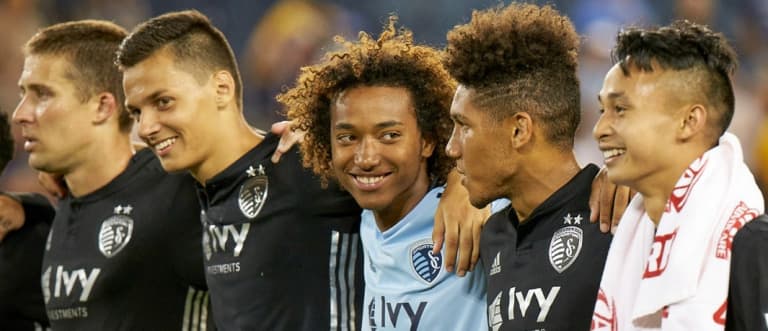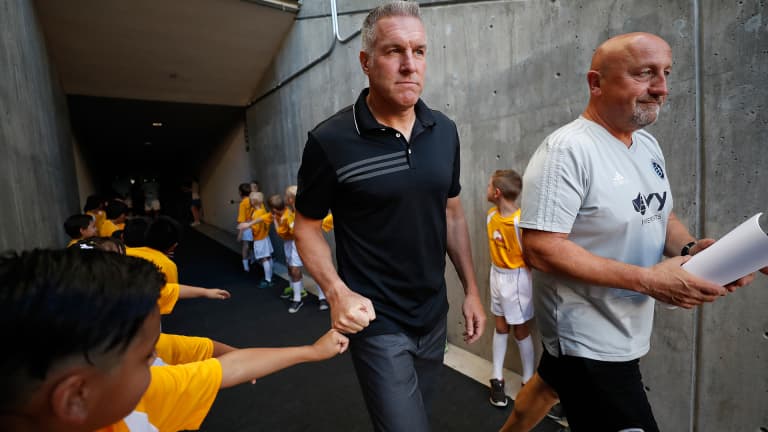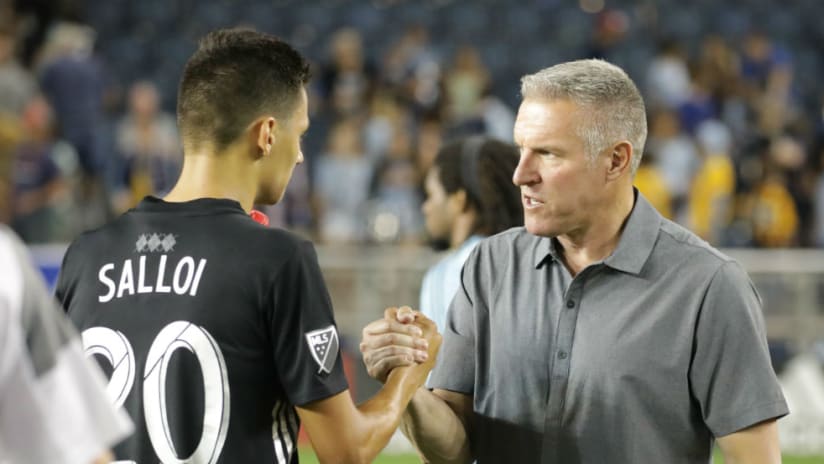Gianluca Busio was handed a daunting task when he joined Sporting Kansas City’s first team last winter for his first preseason as a professional.
“All the young guys have to sing,” explained the 16-year-old attacker, the youngest signing in Major League Soccer history since Freddy Adu. “It was me and a couple other Homegrowns and rookies, we had a dinner in preseason and at the end everybody got up to sing their song.
“I sang ‘Ain’t No Mountain High Enough.’”
Belting out a Motown classic in front of all your coaches and colleagues is no cakewalk. But the fact that this ranks as one of the trickiest rites of passage in Busio’s rise from academy starlet to man of the match in his first MLS start last month says a great deal about Sporting’s quietly-unfolding youth movement, and the carefully-constructed pathway facilitating it.
And, of course, the manager and sporting director who built it.
Peter Vermes has served in the latter position for nearly 12 years, and has also manned the former role for nine of them. The longest-tenured coach in the league, he turns 52 later this year and is under contract through 2023, having won four major trophies over the past six seasons while building one of the most recognizable team identities in MLS. And he’s done so with a relatively steady core of personnel, starting with the key quartet of veteran leaders the club re-signed to contract extensions this week.
Despite, or perhaps because of, all that experience, Vermes is also overseeing a measured but still striking evolution of his roster, bringing three teenage Homegrowns on board – Busio, defender Jaylin Lindsey and central midfielder Wan Kuzain Wan Kamal – over the past year in addition to Daniel Salloi, 22, a 2016 signing who’s grown into a regular starter this season.
“It’s easy to forget that gosh, we have a 16- or 18-year-old kid in the midst of a bunch of men that are married with kids and all that kind of stuff,” Vermes told MLSsoccer.com this week. “So you have to be alert to that and be aware of it … but these kids that are coming in, the Busios, the Kuzains, the Lindseys of the world, they’re a lot more mature than you think they are.
“I use [Busio] as an example – he’s incredibly focused on wanting to be a professional soccer player that he has created his life around being that, and that means you have to sacrifice things. And so he’s also in tune to it, and you can tell. At the same time our older players, I think, do a very, very good job in helping mentor those guys along the way, and it’s great for them to be able to have role models like that, that they can learn from. Because there was a time in this country, especially in my time coming up, we really didn’t have those guys.”
The aforementioned four were recruited from outside the KC area – from as close as southern Illinois and as distant as Eastern Europe. All four progressed from the club’s youth academy through its USL affiliate, Swope Park Rangers, and on to the senior squad.
And all four are seen as the first of many more to come.
“All of us younger kids know that there’s a pathway in here from the academy to Swope Park to the first team,” said Wan Kuzain. “We know that it’s proven, we know that there are going to be a lot more kids coming up – the U-12s, the U-13s, they call can look up to us and know that it’s possible.
“My experience overall [with Vermes] has been really, really good. He knows what to do, he knows what he’s talking about. He’s played in the league, he’s played with the national team and overall you just listen to him when he talks – you want to learn.”

(L to R) SKC's Matt Besler and Homegrowns Salloi, Busio, Lindsey and Wan Kuzain | USA Today Sports Images
Many MLS fans recognize Vermes mainly for his animated presence along the touchline during matches, where he stalks his technical area and keeps up an impassioned dialogue with his players and – particularly – referees. That is only one facet of personality, however, as his youngest charges explain.
“I was kind of scared to talk to him at first – you know, I’m just some academy guy going into first-team training,” Busio recalled of his first meeting with Vermes. “After getting to play under him for a couple months now, I realized that he’s really a great coach – he also has a fun side to him, cracking jokes and everything.
“You can talk to your coach about different things and he’s always talking about non-soccer things,” Busio added. “He has a very serious side when he needs something done, and on the field he works. But outside of that, he’s just like one of the teammates.”
A US national team regular in his own playing days, Vermes was a member of the generation that had to journey abroad to build a sustainable career in the era between the old NASL’s demise and the rise of MLS. He plied his trade in Hungary, the Netherlands and Spain before returning Stateside to join the fledgling league in 1995, and those experiences inform his approach today.
“Because the game was just kind of starting again after the NASL went away, we really didn’t have all these role models to look up to,” he said. “So it was kind of like forging new territory on your own, and making those mistakes, where these guys [today] got an incredible progression going through the pro pathway and learning along the way, which is great for them, and having a B team in our USL team and being able to go and still play and get 90 minutes and still play against men, but maybe not be under the same type of pressure they would be with the first team.”
Many coaches will tell you that players from the millennial generation are a different breed to those who came before them. Vermes, though, sees that trend across his entire roster.
“The game is much more cerebral today in that you spend a lot more time breaking down film, working on your model of play, the different phases of the game,” he said. “Whereas back in, for instance, my time, there were things that were just expected of us, and we had to learn on the fly, we had to learn through trial and error. We learned by survival, if you will. The tactical approach wasn’t as emphasized as it is today.
“We spend SO much time breaking down the game,” he explained. “And you can’t just do it one way. You don’t just show video and then expect everybody to know it. Some guys learn by the video. Some guys, you just need to talk to them. Some times, you need to run it through on the field. So you’re doing all those things week after week after week. So I think players today – and it’s also not just the players themselves, it’s the culture of soccer today, in that players are more learned soccer players than they are developed in the streets or in the backyards or playgrounds.”
If you’re wondering why Vermes would invest seven figures in new deals for 30-somethings like Matt Besler, Roger Espinoza and Graham Zusi just as SKC’s young Homegrowns are coming into their own, it comes back to one of the foundational values of his project: Culture and consistency.
“There’s a consistency within the core group of guys. And as long they continue to have the same motivation or even more, for what the club’s philosophy is around the team, then it only makes sense for those guys to continue to be a part of that core group,” Vermes explained. “Those guys have been here since I either drafted them or brought them to the team, and we have obviously a longstanding relationship – they have been a part of building the culture here, which is an important aspect of any organization, to either success or failure. And when you start to bring a youth movement in, or even just bring new players in, you want to make sure that you continue with that.
“The whole idea is to try to continue to bring along those other, younger players within that culture so that they can continue to perpetuate that culture.”

Peter Vermes | USA Today Sports Images
Vermes has taken care to instill the same concepts, patterns and tactics at every level of Sporting’s system, to help set his youngsters up for success once they get the call-up to the big show.
It’s a big reason why the kids pick SKC in the first place.
“When I came here to look at the academy system,” said Busio, a North Carolina native, “I could see how the path to being a professional was very clear for them and how they wanted it. And I thought that made it a lot easier to achieve one of my goals, and that’s to be a professional. They made it really clear how they wanted it done and how it could be done.
“Once you spend a couple months with the team and the guys, it’s pretty clear what you need to do and how they want it done. Once you get used to it, you fit right in,” said Busio. “Peter does a great job of making sure we all know how he wants it done and it’s been working. He’s been coach for a long time and he knows how to do it.”













